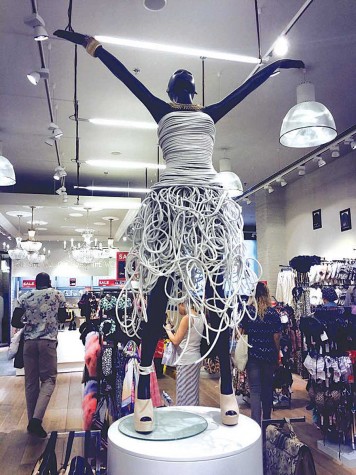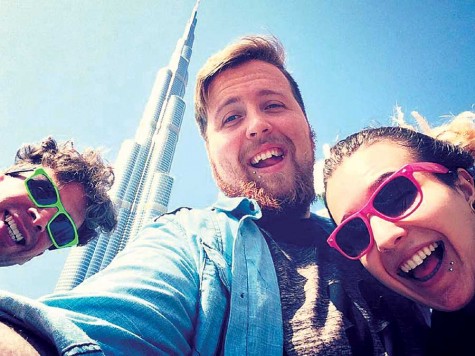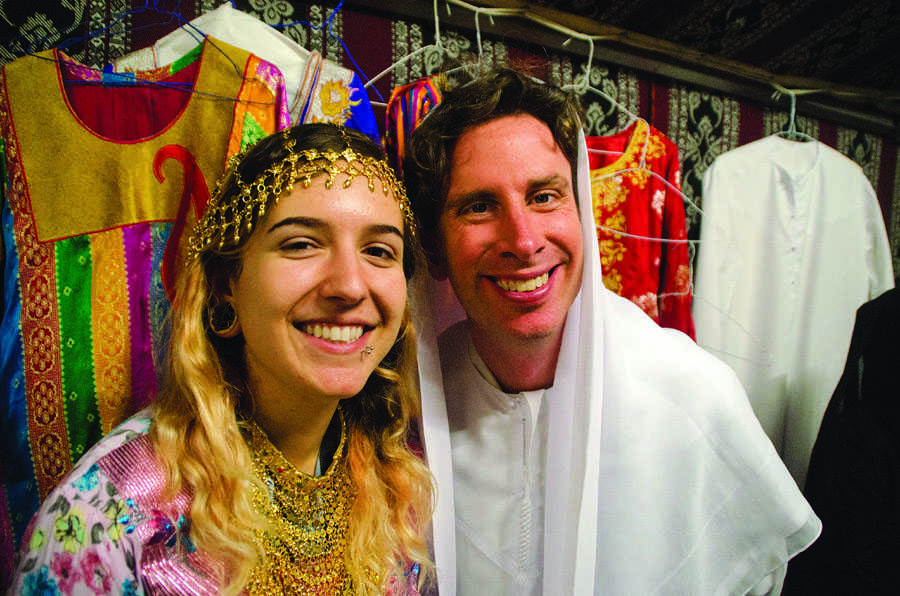Culture-shockingly nice: one professor, two students and art in Dubai
Jessie Warren and Prof. Sean Clute
Assistant Professor of Fine Arts Sean Clute and two JSC students flew 26 hours to attend the International Symposium on Electronic Arts (ISEA) in Dubai from Oct. 30 to Nov. 8.
Accompanying Clute on the life-changing trip was digital art students Jessie Warren and Lance Caron.
The event gathers artists from around the world to evaluate and share the growing role of technology-infused art.
After their ISEA applications were accepted, Caron and Warren were provided financial aid by President Murphy through the special initiatives fund, which helped send the group overseas.
The culture sharing/shock is unavoidable as the symposium travels to a different city across the globe every year. In the past decade the event has been hosted in Finland, Ireland, Germany, the United States, Turkey, and Australia.
This year’s location was one of the seven emirates that is a part of the United Arab Emirates, a country that is home to over 9,000,000 people.
The nation is located in the southeast end of the Arabian Peninsula on the Persian Gulf. It borders Saudi Arabia to the south and Oman to the east, and shares sea borders with Iran and Qatar. Dubai is the UAE’s largest city.
For Clute and his gang, common stereotypes of middle-east culture were overshadowed by reality; ISEA taught them the wonder and generosity of the Dubai people.
“I could see on this little digital map that we were flying over Iran, and that kind of freaked me out a little bit, just knowing all the kind of chaos that’s happening in the Middle East,” said Clute.
When the JSC crew arrived at the hotel, the televisions were playing CNN coverage of recent beheadings of journalists and aid workers.
“You see the images, and I’m a very open minded individual, but you can’t help but have a little fear creep inside knowing that the people in these videos look very similar to the people that we were all of a sudden surrounded by,” said Clute. “It didn’t take long to realize that these are the nicest people and these students are just like our students,” he said.
The welcoming ceremony included choreographed dancing with sword-wielding and traditional garb (black robes and burka for women, and long white robes for men), a whole lot of food and Arabic coffee, umbrella marches with LED lights, and instruction on how males and females should interact while in Dubai.
“You get to this conference and there’s this person who greeted us and basically went over the rules. One of the rules are men are not allowed to talk to women. Women are allowed to talk to men, but [men] are not supposed to engage in conversation,” said Clute.
The photo policy also disallowed women being photographed, and men couldn’t be photographed without permission.
During this first night, Warren was given a push by Clute to go talk with the young Muslim women who were socializing in a tent separate from where the visitors interacted, and separate from where the Muslim men interacted. Warren ended up getting elaborate henna painted on her skin and started cultivating friendship and understanding of this new culture.
For the JSC crew, it was surprising to see how similar the robe-wearing culture is to western culture. “There were all of these women putting up their national flag, and what was interesting is that you have like a hundred women in burkas all on their cellphones, all on iPhones,” said Clute.
“They wear the traditional dress, but some of them wore these really elaborate heels and pumps and things like that,” said Caron. “I remember one of them was yelling to their mother, ‘these heals are killing me, I’m sick of walking.’ Their culture is rather westernized, yet they can integrate their own culture into it without having that division, and manage to bring it all into one melting pot.”
A Muslim man who is in charge of the local historic Sheikh Mohammad Centre invited the JSC visitors to a massive dinner, wherein he described the origins of the female dress. “I remember him explaining how westerners feel that it’s demeaning to women that they have to wear black,” said Caron. “[He said] they wear it [by] choice, it’s not a man saying [they] have to wear it, it’s them deciding they don’t feel like showing their identity, they can go out without people saying, ‘oh, there goes so and so.’”
Although calm and open-minded, Caron had some initial anxiety. A breakthrough moment came during his visit to the tallest building in the world. “When I went up the Burj Khalifa, interacting with those people there was really comforting because they were concerned about [my] comfort. They wanted to make sure [visitors] didn’t have to stress out about anything.”
The event allowed Clute, Warren, and Caron to interact with many visitors from around the world, and realize that the pursuit of an artist goes beyond skin color and nationality.
Throughout the symposium, representatives of ISEA attempted to debunk stereotypes and teach about the Muslim and Arab cultures that are prevalent in Dubai.
By chance, Clute found himself sharing a van with the chair if ISEA, where the two began talking about cultural goal of the organization. “ISEA is unique because not only is it about electronic art, it’s about culture,” said Clute. “They pick these locations that have distinct cultures and they try to find ways of expressing and integrating the culture and technology and expression.”
The art exhibits were set across the city, some within major universities and some on the streets surrounding.
Clute’s exhibit took the majority of a humid day to set up. The team had to move locations after a scheduling mishap, where their exhibit and a flying Barbie doll exhibit were promised the same spot.
“Lance and Jessie stood on ladders and stringed up video projections in 90 degree weather,” said Clute. “We created a site-specific video installation. I’ve been working with a video artist in California and she created these multiple video projections. They go onto these screens or fabrics that blend in the environment and move in the wind. We had many of them up [and] multiple projectors. They become kind of ghostly. I created a 40-minute sound piece that would accompany the projections. If you sit there as an observer long enough, you might just catch a wave of coolness.”
Warren described the piece as galaxy-like and otherworldly.
Warren is an artist who deals in photo and video. Her work is often inspired by her activism for women and animal rights. “I like documentary photography,” said Warren. “I want to be a documentary photographer and filmmaker when I graduate, so I’m going to travel and do that.”
Caron also uses photo and video as a medium for his work. His passions are widespread but he often focuses on fashion and portraiture. He also works with abstract video and sound.
The work Clute and the students saw was visionary and mind-opening.
“We saw so many talks by artists from all over the world,” said Clute. “Not one of them mentioned Photoshop. Media art can encompass so many things; it’s really new terrain. We saw these movable creature-sculptures that would move on the beach and were powered by wind and water. They were huge, like an elephant. We saw people work with fishnets, with these large light and video installations and the net would change depending on the sunlight.”
The three artists left inspired to integrate their Dubai experience into their actions and art.
“I’m definitely proud to be a media artist now instead of just like a graphic designer,” said Warren.
Clute, Warren, and Caron will be presenting on their time in Dubai on Dec. 1 in Stearns Cinema.
At the end of the semester Warren and Caron will be showing their work together, hopefully in the Julian Scott Memorial Gallery.


Travis LeClair joined the Basement Medicine staff in Spring 2014, assuming the position of staff reporter.




